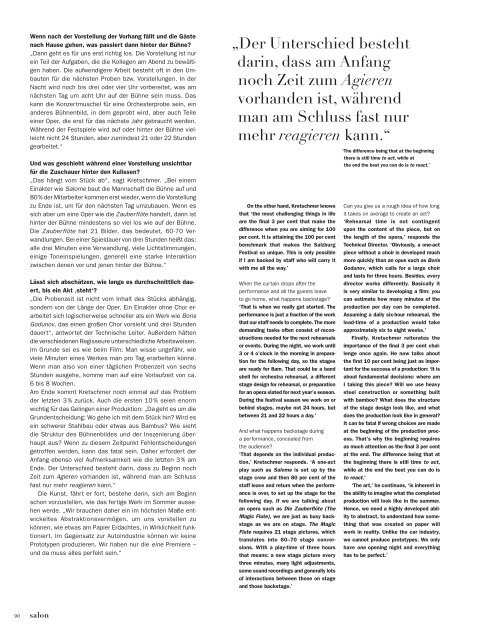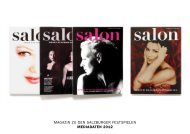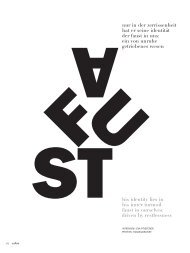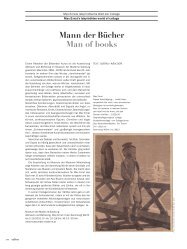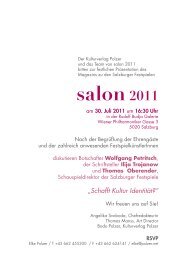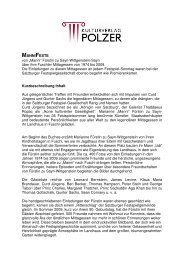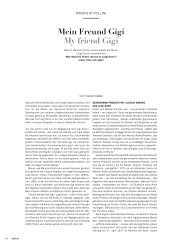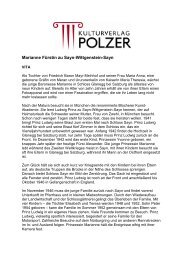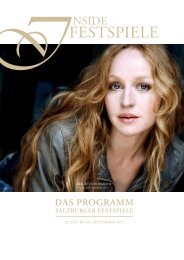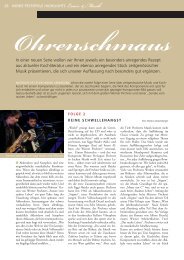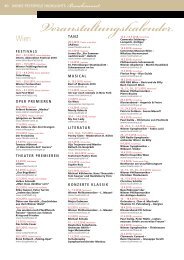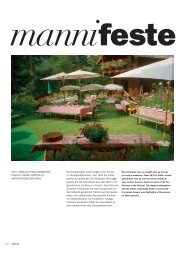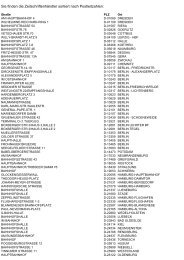TEXT: OLIVER TSCHURTSCHENTHALER PHOTOS: LUIGI CAPUTO
TEXT: OLIVER TSCHURTSCHENTHALER PHOTOS: LUIGI CAPUTO
TEXT: OLIVER TSCHURTSCHENTHALER PHOTOS: LUIGI CAPUTO
Sie wollen auch ein ePaper? Erhöhen Sie die Reichweite Ihrer Titel.
YUMPU macht aus Druck-PDFs automatisch weboptimierte ePaper, die Google liebt.
Wenn nach der Vorstellung der Vorhang fällt und die Gäste<br />
nach Hause gehen, was passiert dann hinter der Bühne?<br />
„Dann geht es für uns erst richtig los. Die Vorstellung ist nur<br />
ein Teil der Aufgaben, die die Kollegen am Abend zu bewältigen<br />
haben. Die aufwendigere Arbeit besteht oft in den Umbauten<br />
für die nächsten Proben bzw. Vorstellungen. In der<br />
Nacht wird noch bis drei oder vier Uhr vorbereitet, was am<br />
nächsten Tag um acht Uhr auf der Bühne sein muss. Das<br />
kann die Konzertmuschel für eine Orchesterprobe sein, ein<br />
anderes Bühnenbild, in dem geprobt wird, aber auch Teile<br />
einer Oper, die erst für das nächste Jahr gebraucht werden.<br />
Während der Festspiele wird auf oder hinter der Bühne vielleicht<br />
nicht 24 Stunden, aber zumindest 21 oder 22 Stunden<br />
gearbeitet.“<br />
Und was geschieht während einer Vorstellung unsichtbar<br />
für die Zuschauer hinter den Kulissen?<br />
„Das hängt vom Stück ab“, sagt Kretschmer. „Bei einem<br />
Einakter wie Salome baut die Mannschaft die Bühne auf und<br />
80% der Mitarbeiter kommen erst wieder, wenn die Vorstellung<br />
zu Ende ist, um für den nächsten Tag umzubauen. Wenn es<br />
sich aber um eine Oper wie die Zauberflöte handelt, dann ist<br />
hinter der Bühne mindestens so viel los wie auf der Bühne.<br />
Die Zauberflöte hat 21 Bilder, das bedeutet, 60-70 Verwandlungen.<br />
Bei einer Spieldauer von drei Stunden heißt das:<br />
alle drei Minuten eine Verwandlung, viele Lichtstimmungen,<br />
einige Toneinspielungen, generell eine starke Interaktion<br />
zwischen denen vor und jenen hinter der Bühne.“<br />
Lässt sich abschätzen, wie lange es durchschnittlich dauert,<br />
bis ein Akt ‚steht‘?<br />
„Die Probenzeit ist nicht vom Inhalt des Stücks abhängig,<br />
sondern von der Länge der Oper. Ein Einakter ohne Chor erarbeitet<br />
sich logischerweise schneller als ein Werk wie Boris<br />
Godunov, das einen großen Chor vorsieht und drei Stunden<br />
dauert“, antwortet der Technische Leiter. Außerdem hätten<br />
die verschiedenen Regisseure unterschiedliche Arbeitsweisen.<br />
Im Grunde sei es wie beim Film: Man wisse ungefähr, wie<br />
viele Minuten eines Werkes man pro Tag erarbeiten könne.<br />
Wenn man also von einer täglichen Probenzeit von sechs<br />
Stunden ausgehe, komme man auf eine Vorlaufzeit von ca.<br />
6 bis 8 Wochen.<br />
Am Ende kommt Kretschmer noch einmal auf das Problem<br />
der letzten 3 % zurück. Auch die ersten 10 % seien enorm<br />
wichtig für das Gelingen einer Produktion: „Da geht es um die<br />
Grundentscheidung: Wo gehe ich mit dem Stück hin? Wird es<br />
ein schwerer Stahlbau oder etwas aus Bambus? Wie sieht<br />
die Struktur des Bühnenbildes und der Inszenierung überhaupt<br />
aus? Wenn zu diesem Zeitpunkt Fehlentscheidungen<br />
getroffen werden, kann das fatal sein. Daher erfordert der<br />
Anfang ebenso viel Aufmerksamkeit wie die letzten 3 % am<br />
Ende. Der Unterschied besteht darin, dass zu Beginn noch<br />
Zeit zum Agieren vorhanden ist, während man am Schluss<br />
fast nur mehr reagieren kann.“<br />
Die Kunst, fährt er fort, bestehe darin, sich am Beginn<br />
schon vorzustellen, wie das fertige Werk im Sommer aussehen<br />
werde. „Wir brauchen daher ein im höchsten Maße entwickeltes<br />
Abstraktionsvermögen, um uns vorstellen zu<br />
können, wie etwas am Papier Erdachtes, in Wirklichkeit funktioniert.<br />
Im Gegensatz zur Autoindustrie können wir keine<br />
Prototypen produzieren. Wir haben nur die eine Premiere –<br />
und da muss alles perfekt sein.“<br />
„Der Unterschied besteht<br />
darin, dass am Anfang<br />
noch Zeit zum Agieren<br />
vorhanden ist, während<br />
man am Schluss fast nur<br />
mehr reagieren kann.“<br />
On the other hand, Kretschmer knows<br />
that ‘the most challenging things in life<br />
are the final 3 per cent that make the<br />
difference when you are aiming for 100<br />
per cent. It is attaining the 100 per cent<br />
benchmark that makes the Salzburg<br />
Festival so unique. This is only possible<br />
if I am backed by staff who will carry it<br />
with me all the way.’<br />
When the curtain drops after the<br />
performance and all the guests leave<br />
to go home, what happens backstage?<br />
‘That is when we really get started. The<br />
performance is just a fraction of the work<br />
that our staff needs to complete. The more<br />
demanding tasks often consist of reconstructions<br />
needed for the next rehearsals<br />
or events. During the night, we work until<br />
3 or 4 o’clock in the morning in preparation<br />
for the following day, so the stages<br />
are ready for 8am. That could be a band<br />
shell for orchestra rehearsal, a different<br />
stage design for rehearsal, or preparation<br />
for an opera slated for next year’s season.<br />
During the festival season we work on or<br />
behind stages, maybe not 24 hours, but<br />
between 21 and 22 hours a day.’<br />
And what happens backstage during<br />
a performance, concealed from<br />
the audience?<br />
‘That depends on the individual production,’<br />
Kretschmer responds. ‘A one-act<br />
play such as Salome is set up by the<br />
stage crew and then 80 per cent of the<br />
staff leave and return when the performance<br />
is over, to set up the stage for the<br />
following day. If we are talking about<br />
an opera such as Die Zauberflöte (The<br />
Magic Flute), we are just as busy backstage<br />
as we are on stage. The Magic<br />
Flute requires 21 stage pictures, which<br />
translates into 60–70 stage conversions.<br />
With a play-time of three hours<br />
that means: a new stage picture every<br />
three minutes, many light adjustments,<br />
some sound recordings and generally lots<br />
of interactions between those on stage<br />
and those backstage.’<br />
‘The difference being that at the beginning<br />
there is still time to act, while at<br />
the end the best you can do is to react.’<br />
Can you give us a rough idea of how long<br />
it takes on average to create an act?<br />
‘Rehearsal time is not contingent<br />
upon the content of the piece, but on<br />
the length of the opera,’ responds the<br />
Technical Director. ‘Obviously, a one-act<br />
piece without a choir is developed much<br />
more quickly than an opus such as Boris<br />
Godunov, which calls for a large choir<br />
and lasts for three hours. Besides, every<br />
director works differently. Basically it<br />
is very similar to developing a film: you<br />
can estimate how many minutes of the<br />
production per day can be completed.<br />
Assuming a daily six-hour rehearsal, the<br />
lead-time of a production would take<br />
approximately six to eight weeks.’<br />
Finally, Kretschmer reiterates the<br />
importance of the final 3 per cent challenge<br />
once again. He now talks about<br />
the first 10 per cent being just as important<br />
for the success of a production: ‘It is<br />
about fundamental decisions: where am<br />
I taking this piece? Will we use heavy<br />
steel construction or something built<br />
with bamboo? What does the structure<br />
of the stage design look like, and what<br />
does the production look like in general?<br />
It can be fatal if wrong choices are made<br />
at the beginning of the production process.<br />
That’s why the beginning requires<br />
as much attention as the final 3 per cent<br />
at the end. The difference being that at<br />
the beginning there is still time to act,<br />
while at the end the best you can do is<br />
to react.’<br />
‘The art,’ he continues, ‘is inherent in<br />
the ability to imagine what the completed<br />
production will look like in the summer.<br />
Hence, we need a highly developed ability<br />
to abstract, to understand how something<br />
that was created on paper will<br />
work in reality. Unlike the car industry,<br />
we cannot produce prototypes. We only<br />
have one opening night and everything<br />
has to be perfect.’<br />
90<br />
salon<br />
Salon09_27_hinterkulissen_140709.indd 90 16/07/2009 15:42


